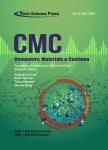Ghost Module Based Residual Mixture of Self-Attention and Convolution for Online Signature Verification
作者机构:Department of Computer TechnologySchool of Computer Science and EngineeringShenyang Jianzhu UniversityShenyang110168China Liaoning Province Big Data Management and Analysis Laboratory of Urban ConstructionShenyang Jianzhu UniversityShenyang110168China Shenyang Branch of National Special Computer Engineering Technology Research CenterShenyang Jianzhu UniversityShenyang110168China
出 版 物:《Computers, Materials & Continua》 (计算机、材料和连续体(英文))
年 卷 期:2024年第79卷第4期
页 面:695-712页
核心收录:
学科分类:08[工学] 080203[工学-机械设计及理论] 0805[工学-材料科学与工程(可授工学、理学学位)] 0802[工学-机械工程] 0812[工学-计算机科学与技术(可授工学、理学学位)]
基 金:National Natural Science Foundation of China(Grant No.62073227) Liaoning Provincial Science and Technology Department Foundation(Grant No.2023JH2/101300212)
主 题:Online signature verification feature selection ACG block ghost-ACmix residual structure
摘 要:Online Signature Verification (OSV), as a personal identification technology, is widely used in various ***, it faces challenges, such as incomplete feature extraction, low accuracy, and computational heaviness. Toaddress these issues, we propose a novel approach for online signature verification, using a one-dimensionalGhost-ACmix Residual Network (1D-ACGRNet), which is a Ghost-ACmix Residual Network that combines convolutionwith a self-attention mechanism and performs improvement by using Ghost method. The Ghost-ACmix Residualstructure is introduced to leverage both self-attention and convolution mechanisms for capturing global featureinformation and extracting local information, effectively complementing whole and local signature features andmitigating the problem of insufficient feature extraction. Then, the Ghost-based Convolution and Self-Attention(ACG) block is proposed to simplify the common parts between convolution and self-attention using the Ghostmodule and employ feature transformation to obtain intermediate features, thus reducing computational ***, feature selection is performed using the random forestmethod, and the data is dimensionally reducedusing Principal Component Analysis (PCA). Finally, tests are implemented on the MCYT-100 datasets and theSVC-2004 Task2 datasets, and the equal error rates (EERs) for small-sample training using five genuine andforged signatures are 3.07% and 4.17%, respectively. The EERs for training with ten genuine and forged signaturesare 0.91% and 2.12% on the respective datasets. The experimental results illustrate that the proposed approacheffectively enhances the accuracy of online signature verification.



